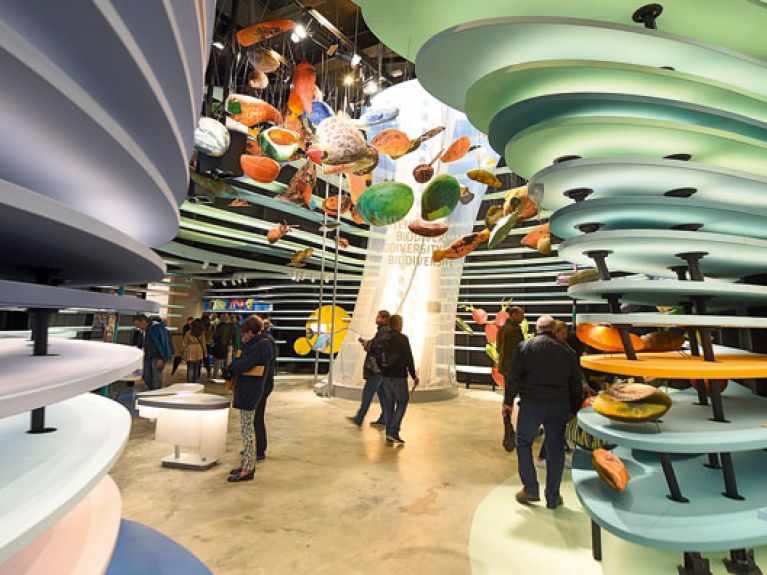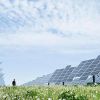Fields of Ideas
The German Pavilion at Expo Milano 2015 interprets the World Exhibition’s theme with the aid of high technology.

You can’t miss the German Pavilion as you stroll along the principal road at the front end of the Expo site. It’s one of the most unusual buildings at the World Exhibition in Milan. The people flood up a wooden ramp to enter the futuristic pavilion. The first things that catch your eye are the large, whitish membrane roofs stretched over the pavilion in the shape of upward-striving plants. Germany is using high technology to interpret the Expo theme of “Feeding the Planet, Energy for Life”. Under the title “Fields of Ideas”, the steel-and-membrane building suggests solutions to one of the great issues of the future.
With its overarching “Feeding the Planet” theme, Expo Milano 2015 creates links between nutrition and sustainability, tradition and innovation, technology and taste. A total of 148 countries are presenting their ideas on these subjects from 1 May until 31 October 2015 – over 50 of them with their own pavilions. Participating nations not represented with their own buildings can be found in the nine pavilions that have been set up as thematic clusters – focusing on cocoa and chocolate, coffee, fruit and vegetables, spices, cereals and tubers, the Mediterranean region, islands and the sea, dry climatic zones, and rice. Also represented are the European Union, the United Nations, the Caribbean Community (CARICOM), 13 non-government institutions and six corporate, interest and lobby organisations.
The 1.1-square-kilometre site is designed as an island surrounded by a canal. All the pavilions and facilities can be reached via the two axes Decumanus and Cardo. The national pavilions are spread out along the 1.5-kilometre-long and 35-metre-wide main boulevard; the pavilions representing Italy’s regions and provinces are on the 325-metre-long Cardo. The intersection of the two axes is called Piazza Italia. At the northern end of the Cardo is Lake Arena, which is 98 metres in diameter; the southern end features an open-air theatre that seats around 9,000 people. Some 20 million visitors are expected during the six-month Expo period, entering the site via the two main entrances to the south and west.
Germany aims to make a mark as a country of ideas on sustainability and feeding the world’s population in the future – all this in a calm manner aimed at fostering confidence and mutual trust. Visitors can wander through the Fields of Ideas along two routes. The first, outside route leads them up to the landscape level via a broad ramp, inviting everyone to take a stroll and enjoy life. The second route leads people through the exhibition inside the pavilion, past the great variety of exhibits, ending in a room housing the “Be(e) active” show: a film, just over twelve minutes long, that introduces visitors to Germany through the eyes of two bees in flight.
But before they become immersed in the six themes – Water, Soil, Climate, Biodiversity, Foodstuffs and My Garden of Ideas – each visitor is given a so-called Seedboard at the entrance. This is a fold-out 20x10-centimetre piece of corrugated cardboard that is meant to function like a tablet computer. The inside surface is coated with a special kind of white paper that serves as a projection surface for all the virtual content on offer in the pavilion – text, images, films and games. Information on exhibits can be accessed and controlled with the Seedboard; selected items can be collected and stored. For example, turning and moving the board takes visitors on a journey through time explaining the history of Lake Constance, specifically its creation and phases of pollution and purification. Seedboards are available in German, English, French and Italian. At each information display, the language is recognised by very thin minichips attached to the white paper. The board also plays a role in the Be(e) active show, generating sounds and rhythms. The Seedboard has already become a coveted souvenir.
About 100 ideas are presented in the German pavilion, for example the “tomato fish” and a “climate calculator”. The tomato fish relates to the simultaneous farming of fish and tomatoes in a closed-loop system. The climate calculator from Hamburg is one of the most efficient in the world; it can conduct detailed simulation experiments with climate models or generate scenarios on the development of agricultural yields.
But the main attractions are the Solar Trees growing out of the pavilion. As “idea seedlings”, they stand not only for the concept of growing ideas, they also have two additional functions: one an ecological, practical one, the other business-oriented. During the day, the Solar Trees refuel by soaking up the sun; at night, the stored solar energy is used to illuminate the building – but using not conventional solar cells, but extremely thin films made of absorbent polymer materials. “The flow of electricity is displayed using light-emitting diodes, thus making the solar energy visible and tangible for visitors,” says Lennart Wiechell, architect at Schmidhuber, the company responsible for the pavilion’s design. Because they are so thin and flexible, the organic photovoltaic modules can be integrated into the films and vary greatly in shape and colour. “This technology offers completely new possibilities for the solar and creative industries,” says Wiechell. ▪
Text: Die Welt

